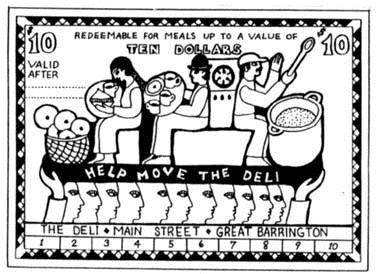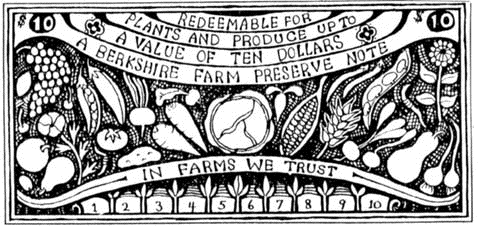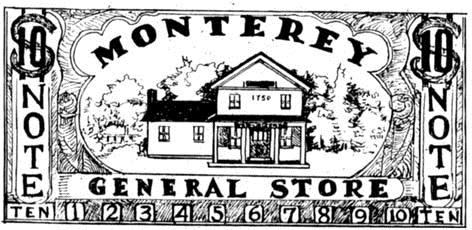|
A Tonic for Local Economy
by Linda Pascatore
© 1993The Gobbler, Summer Growth
Barter and other non-traditional ways of paying
for goods and services have recently been making a comeback.
People are bartering more in small personal transactions, and
many larger bartering services are cropping up around the country.
Small businesses turned down for bank loans are borrowing from
their customers through the use of notes or script. Many social
agencies like churches, HMO's (Health Maintenance Organizations),
and even state governments have set up mutual aid systems based
on "time dollars" where volunteers exchange services. Although
these transactions seem strange at first, in some ways they
are a more natural exchange than our current monetary system.
Before there was money, people used to barter.
They traded a product they had or a service they could provide
for other goods or services they wanted. Simple barter only
worked as long as there was a direct match in need. As communities
grew and things got more complicated, barter became awkward
and ineffective. At first, currency was often a real commodity
valued by all. Iron nails were used as currency in Scotland,
sugar in the West Indies, and corn in the American colonies.
Roman soldiers were paid in salt. Gold, silver and copper coins
were widely used. Early Latin coins pictured a cow and could
be exchanged for the real thing.
Paper money didn't appear until the 18th Century,
and central banking was a relatively new phenomenon, instituted
in the US in 1913 with the Federal Reserve Act. Money was at
first backed by gold and silver reserves. This practice was
changed by President Roosevelt in 1933. From that point on,
US citizens could no longer exchange their notes for gold. Nixon
extended this policy to foreign holders in 1971.
Many European cities issued their own local
currencies well into the l9th Century. There was a short lived
revival of this practice during the Great Depression, when a
city in Austria was short on cash, but needed work done on a
bridge and drainage project. They issued "tickets for services
rendered" to workers, which could be used to pay local taxes.
These notes circulated widely and stimulated the economy. Nearby
towns followed suit, and were brought out of poverty to relative
prosperity using local script. As the idea grew, the Austrian
Central Bank took the towns to court and the local currencies
were declared unconstitutional. In this country, such currencies
are legal as long as they can be exchanged for US dollars and
transactions involving them can be taxed.
The recent revival of local currencies has
taken Great Barrington, in Massachusetts, by storm. Local script
(see illustrations below) can now be found in cash registers
all over town. It all started when the lease on a local deli
expired and the owner applied for a small loan for renovations
so he could move the deli across the street. Because of the
depressed economy, he was turned down by all the local banks.
He bet that his loyal customers would be willing to invest in
him. He printed script called "Deli Dollars". They sold for
$9 and were worth $10 in deli food, but customers had to wait
at least six months to redeem them. These notes constituted
a short-term loan to the deli owner, who successfully sold his
script and moved his business. The idea took off, and soon many
local businesses were following suit, including another restaurant,
two farms, and a general store. Many of these businesses honor
each other's currency, and the local minister was surprised
but pleased to find Deli Dollars in his collection plate.

Berkshire Farm Preserve Notes are helping a
farm couple make it through slow winter seasons. They run two
farm stands which are open year round, selling potatoes, flowers
and Christmas trees during the winter. However, the rush of
business is in the summer. These notes read, "In Farms We Trust"
and have a head of cabbage where George Washington is normally
found. They are sold for $9 from October through March, and
redeemed for $10 worth of produce during the summer at one of
the two farm stands.


There has also been more widespread use of
barter recently. It has always continued at a personal level
between friends and in small communities. The Amish work in
a system with less cash flow, and they frequently use barter.
As Middle America experiences layoffs and loss of jobs, barter
is beginning to move to a larger scale. Businesses are getting
their piece of the new market. We have seen advertisements for
corporate barter services.
The lnternal Revenue Service says that barter
for family use is not considered taxable. However, barter of
goods for goods, goods for services, or services for services
are all treated as taxable income when part of any business
venture.
A new alternative to traditional barter and
script systems has been made available largely by computer technology.
This is the "Time Dollar" concept which converts time to money.
This is being used by many volunteer and service agencies throughout
the country. If one member of an organization needs a service,
he is matched to another member volunteer able to provide it.
The volunteer then earns time credits, deposited in the computer
bank, which can be redeemed through buying services from other
members. According to the IRS, these exchanges are exempt from
taxation because they aren't commercial in nature. Community
agencies, churches, schools, hospitals, and colleges are all
using time shares.
Elderplan, an HM0 for senior citizens in Brooklyn,
is using the time share concept. A volunteer might run errands,
transport patients to a doctor's appointment, do housework,
or provide non-medical supervision for another member in need.
The volunteer earns credits which can be used to reduce monthly
health care premiums, or save to redeem for services. In the
long run, this system keeps people independent and out of nursing
homes, and saves home health aide costs. HM0 premiums are reduced
and all the members save money. It is also an insurance policy
that guarantees that volunteers who donate time today will receive
services tomorrow when their own health might deteriorate.
Time dollars, barter, and local currency might
all prove stimulating to the economy of our communities. If
a time share system rewarded people for caring for neighbors
in need, tax dollars going to health care and social services
would be reduced. Bartering would help people hit hard by a
changing economy who are cash poor but have talents or services
to provide. If we were more self-sufficient, providing the bulk
of needed goods and services within our local communities, there
would be more economic stability and we would be less likely
to be hurt if the national economy took a tumble.
The value of local currency would be based
on real products people wanted and could produce. Regional supply
and demand would dictate the value of dollars, rather than national
and international monetary systems far removed from real life
in our communities. We are aware that a world economy exists,
but we feel it would be stabilized by solid regional economic
health.
We would be delighted to use the Gobbler as
a forum for discussion on the subject of creating local currency,
time shares, or barter systems (See related stories: "The Ithaca
Money System", and "Skills Exchange"). Please let us know what
you think of these possibilities and we'll be glad to publish
your reactions.
Sources:
"Bringing the Money Back Home", Utne Reader,
July/August 1992
"Capitalizing On Yankee Ingenuity", The Washington
Post, Monday, May 20, 1991
"Time Dollars", Co-op America Quarterly,
Spring, 1993.
|